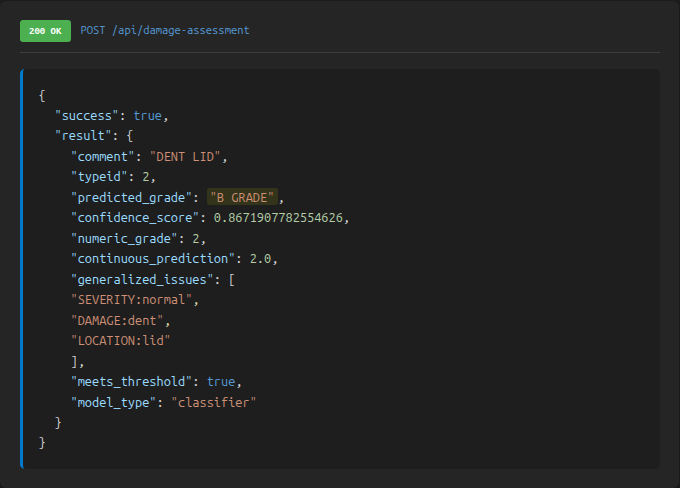Meet Graham: The AI That Ended Grading Wars and Saved Thousands
By Zach Van Dorp
The Human Problem: When Subjectivity Costs Money
"This laptop is clearly B-grade at best!"
Your customer is furious. They ordered an A-grade laptop based on your assessment, but what arrived looks like it survived a small explosion. Meanwhile, your grading team insists they followed the guidelines perfectly.
This scenario played out daily for our IT Asset Management client. They had perfected automated pricing, but their human grading system was bleeding money through inconsistent assessments, customer disputes, and massive labor costs.
The brutal reality: When humans judge condition, emotions, fatigue, and personal standards create chaos.
The Grading Nightmare That Kills Profits
Our client processes thousands of second-hand laptops, phones, and devices monthly. Each one needs a condition grade from A (pristine) to D (heavily damaged) or Recycle (beyond repair). Simple, right?
The Human Factor Disaster:
Inconsistent Standards:
- "Minor scratch" to one person = "significant damage" to another
- Monday morning grader vs Friday afternoon grader = different standards
- New team member vs experienced grader = completely different results
- Personal mood affecting professional judgment
The Real Business Costs:
- Customer disputes over condition vs price mismatches
- Return processing eating into profits
- Reputation damage from inconsistent quality claims
- Massive labor costs with teams manually reviewing thousands of items
- Bottlenecks as grading became the slowest part of operations
The Scale Problem:
Processing thousands of devices meant:
- Reading detailed damage comments for each device
- Analyzing photos from multiple angles
- Weighing combination of damages vs worst single damage
- Considering market feedback on previous similar gradings
- Making subjective calls on borderline cases
Result: Even with guidelines, human graders delivered wildly inconsistent results that customers and the business couldn't rely on.
Meet Graham: The AI Grader That Never Has a Bad Day
Instead of fighting human nature, we built an AI system our client affectionately named "Graham" – a grading engine that brings industrial-level consistency to subjective assessments.
Graham's Technical Foundation:
Natural Language Processing (NLP):
- Analyzes damage descriptions with perfect consistency
- Understands context: "small dent on corner" vs "small dent on screen"
- Processes combinations of multiple damage types
- Never gets tired or distracted
Machine Learning Pipeline:
- Trained on thousands of historical gradings and customer feedback
- Uses XGBoost for complex damage pattern recognition
- Considers depth, size, location, and type of damage
- Learns from market feedback on pricing disputes
Consistent Logic:
- Same assessment criteria applied to every device
- No mood swings, fatigue, or personal bias
- Handles edge cases with learned decision patterns
- Processes thousands in minutes, not days
Real Example: Graham in Action

Input: Laptop with visible dent damage on lid ("DENT LID")

Graham's Output: Detailed analysis with B GRADE assignment
Graham's Analysis for "DENT LID":
- Predicted Grade: B GRADE
- Confidence Score: 86.7%
- Damage Classification: Normal severity dent on lid
- Numeric Grade: 2 (on internal scale)
- Threshold Met: Yes (reliable prediction)
This shows Graham's ability to process simple damage descriptions and deliver consistent, confident grading decisions.
The Graham Advantage: Consistency at Scale
Before Graham:
- 5-10 minutes per device for human assessment
- Inconsistent results between different graders
- Customer disputes over grade vs condition mismatches
- Bottlenecks with manual review processes
- High labor costs for thousands of assessments
After Graham:
- Seconds per device for AI assessment
- Perfect consistency across all evaluations
- Reduced customer disputes through reliable grading
- Massive throughput increase processing thousands instantly
- Significant cost savings eliminating manual grading labor
The Numbers That Matter
- Processing Speed: From 5-10 minutes to seconds per device
- Labor Cost Savings: Tens of thousands in manual grading costs
- Consistency: Perfect repeatability across all assessments
- Customer Satisfaction: Dramatic reduction in grade-related disputes
- Throughput: Thousands of devices processed in minutes vs days
The multiplier effect: At scale, these improvements compound into massive operational advantages.
Beyond Grading: What Graham Unlocked
Graham didn't just solve grading – it transformed the entire operation:
Strategic Pricing Decisions:
- Reliable grades enable confident pricing strategies
- Consistent quality standards build customer trust
- Predictable grading allows better inventory planning
Customer Relationship Protection:
- Accurate condition assessments match customer expectations
- Reduced returns and disputes preserve relationships
- Transparent grading builds long-term trust
Operational Efficiency:
- Grading bottlenecks eliminated completely
- Staff redirected to higher-value activities
- Scalable processing for business growth
The Technology Behind the Magic
Graham combines multiple AI approaches for robust performance:
- Natural Language Processing: Understanding damage descriptions in natural language
- Machine Learning: Pattern recognition for complex damage combinations
- XGBoost Models: Handling non-linear relationships between damage factors
- Customer Feedback Integration: Continuous learning from market responses
The result: An AI system that understands nuance while delivering consistency.
Is Your Business Stuck with Subjective Assessments?
If any of these sound familiar, you might be losing money to human inconsistency:
- Quality assessments that vary between team members
- Customer disputes over condition vs pricing
- Bottlenecks in subjective evaluation processes
- High labor costs for manual review work
- Inconsistent standards affecting customer trust
Every subjective human decision is an opportunity for AI to deliver consistency and scale.
The Future of Consistent Assessment
Graham represents the power of AI to solve fundamentally human problems. Whether it's grading products, assessing damage, evaluating quality, or any subjective business process – AI can deliver the consistency your customers expect and your business needs.
The question isn't whether AI can handle subjective assessments – it's how much longer you'll let human inconsistency cost you money and customers.
Ready to build your own Graham? Contact Artemis Software and Analytics to discover how AI can bring consistency to your subjective business processes. Because your customers deserve predictable quality, and your business deserves predictable results.
Ready to transform your business with AI?
Let's discuss how we can solve your specific challenges with custom AI and data solutions.